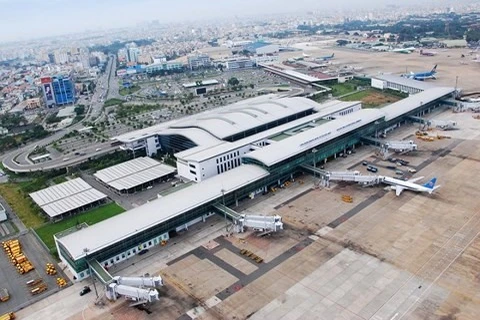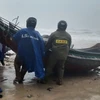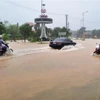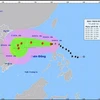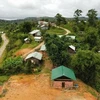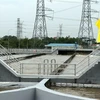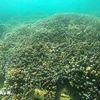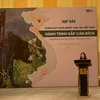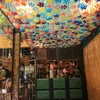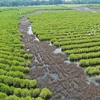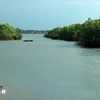Hanoi (VNS/VNA) - The burning of straw, plant byproducts and other waste on fields near airports produces smoke that affects visibility for pilots and poses a high risk to flight safety, said an official from the Northern Airports Authority under the Civil Aviation Authority of Vietnam.
Head of Safety Management of the Northern Airports Authority Truong Hieu Linh told the Vietnam News Agency that smoke from straw burning, flying objects like kites or drones and laser lights threatened aviation safety.
As Noi Bai International Airport is located in an area with farming land around, it has been heavily affected by the long-standing local practice of burning straw/plant byproducts or farming waste after rice harvests in late September or early October, either to get rid of the residue or reduce it to fertiliser ash, Linh said.
According to Hanoi's Department of Natural Resources and Environment, some 300,000 tonnes of straw is burned annually.
A 2012 survey by the Ministry of Agriculture and Rural Development’s crop production department found that of 180,000 Red River Delta households across three provinces, 58 percent burnt straw in the field.
According to Linh, to address the problem relating to laser lights, the National Steering Committee on Anti-terrorism was responsible and had assigned local police to oversee the problem.
The Ministry of National Defence has issued regulations to ban flying objects like kites or drones in areas like airports.
However, it was difficult to control the straw burning, Linh said, adding that local authorities could help detect and punish if farmers burnt farming waste in their fields but it would be difficult to control if the waste was burnt along roadsides.
There are also no specific sanctions for straw burning violations, Linh said, adding that local authorities usually fine the burners for violting social order and security.
Communication activities to improve public awareness on the negative impacts of straw burning on the environment and aviation had been taken but were not as effective as hoped, Linh said.
The official suggested the Government offer incentives to companies to collect farming waste to help curb outdoor straw burning.
Recently, the Hanoi People’s Committee issued a directive on tightening control over the burning of straw, plant byproducts and farming waste to minimise its negative impacts on the environment.
The city also wanted to develop a community monitoring sytem to receive reports on solid waste burning in the city.
Under the directive, this month, the city is informing people about the plan to collect, transport and process straw, plant byproducts, and other waste.
By year’s end, authorities need to deploy supportive measures to encourage citizens to not burn straw and plant byproducts and switch to more environmentally friendly waste processing methods.
From next year, all straw and plant byproducts in the city are expected to be collected and either recycled or processed while abiding by environmental regulations./.
Head of Safety Management of the Northern Airports Authority Truong Hieu Linh told the Vietnam News Agency that smoke from straw burning, flying objects like kites or drones and laser lights threatened aviation safety.
As Noi Bai International Airport is located in an area with farming land around, it has been heavily affected by the long-standing local practice of burning straw/plant byproducts or farming waste after rice harvests in late September or early October, either to get rid of the residue or reduce it to fertiliser ash, Linh said.
According to Hanoi's Department of Natural Resources and Environment, some 300,000 tonnes of straw is burned annually.
A 2012 survey by the Ministry of Agriculture and Rural Development’s crop production department found that of 180,000 Red River Delta households across three provinces, 58 percent burnt straw in the field.
According to Linh, to address the problem relating to laser lights, the National Steering Committee on Anti-terrorism was responsible and had assigned local police to oversee the problem.
The Ministry of National Defence has issued regulations to ban flying objects like kites or drones in areas like airports.
However, it was difficult to control the straw burning, Linh said, adding that local authorities could help detect and punish if farmers burnt farming waste in their fields but it would be difficult to control if the waste was burnt along roadsides.
There are also no specific sanctions for straw burning violations, Linh said, adding that local authorities usually fine the burners for violting social order and security.
Communication activities to improve public awareness on the negative impacts of straw burning on the environment and aviation had been taken but were not as effective as hoped, Linh said.
The official suggested the Government offer incentives to companies to collect farming waste to help curb outdoor straw burning.
Recently, the Hanoi People’s Committee issued a directive on tightening control over the burning of straw, plant byproducts and farming waste to minimise its negative impacts on the environment.
The city also wanted to develop a community monitoring sytem to receive reports on solid waste burning in the city.
Under the directive, this month, the city is informing people about the plan to collect, transport and process straw, plant byproducts, and other waste.
By year’s end, authorities need to deploy supportive measures to encourage citizens to not burn straw and plant byproducts and switch to more environmentally friendly waste processing methods.
From next year, all straw and plant byproducts in the city are expected to be collected and either recycled or processed while abiding by environmental regulations./.
VNA



